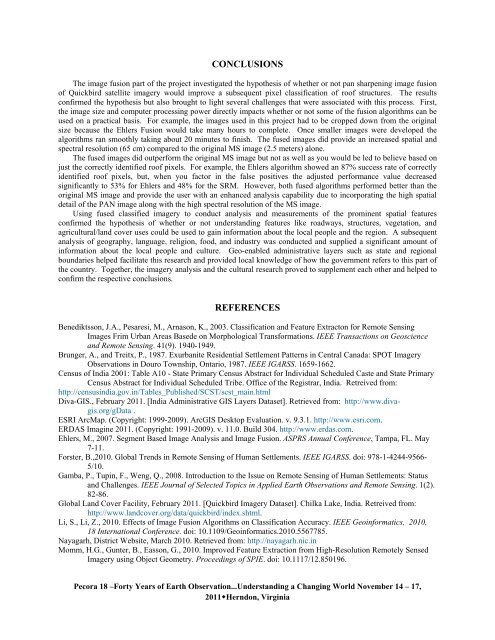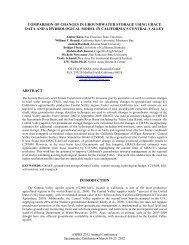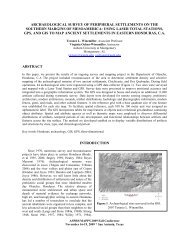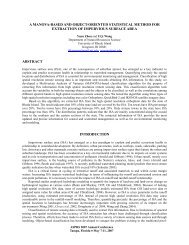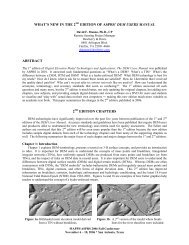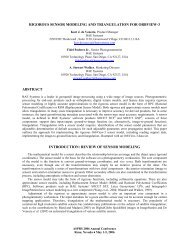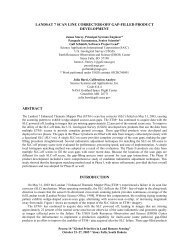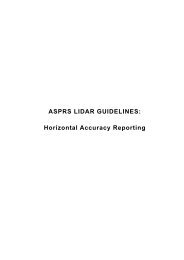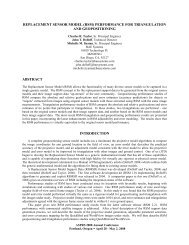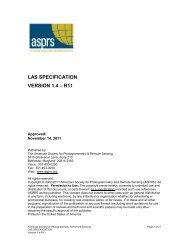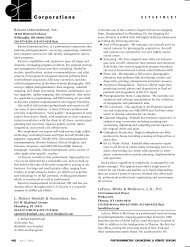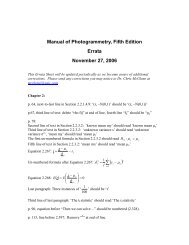using image fusion and classification to profile a human ... - asprs
using image fusion and classification to profile a human ... - asprs
using image fusion and classification to profile a human ... - asprs
Create successful ePaper yourself
Turn your PDF publications into a flip-book with our unique Google optimized e-Paper software.
CONCLUSIONS<br />
The <strong>image</strong> <strong>fusion</strong> part of the project investigated the hypothesis of whether or not pan sharpening <strong>image</strong> <strong>fusion</strong><br />
of Quickbird satellite <strong>image</strong>ry would improve a subsequent pixel <strong>classification</strong> of roof structures. The results<br />
confirmed the hypothesis but also brought <strong>to</strong> light several challenges that were associated with this process. First,<br />
the <strong>image</strong> size <strong>and</strong> computer processing power directly impacts whether or not some of the <strong>fusion</strong> algorithms can be<br />
used on a practical basis. For example, the <strong>image</strong>s used in this project had <strong>to</strong> be cropped down from the original<br />
size because the Ehlers Fusion would take many hours <strong>to</strong> complete. Once smaller <strong>image</strong>s were developed the<br />
algorithms ran smoothly taking about 20 minutes <strong>to</strong> finish. The fused <strong>image</strong>s did provide an increased spatial <strong>and</strong><br />
spectral resolution (65 cm) compared <strong>to</strong> the original MS <strong>image</strong> (2.5 meters) alone.<br />
The fused <strong>image</strong>s did outperform the original MS <strong>image</strong> but not as well as you would be led <strong>to</strong> believe based on<br />
just the correctly identified roof pixels. For example, the Ehlers algorithm showed an 87% success rate of correctly<br />
identified roof pixels, but, when you fac<strong>to</strong>r in the false positives the adjusted performance value decreased<br />
significantly <strong>to</strong> 53% for Ehlers <strong>and</strong> 48% for the SRM. However, both fused algorithms performed better than the<br />
original MS <strong>image</strong> <strong>and</strong> provide the user with an enhanced analysis capability due <strong>to</strong> incorporating the high spatial<br />
detail of the PAN <strong>image</strong> along with the high spectral resolution of the MS <strong>image</strong>.<br />
Using fused classified <strong>image</strong>ry <strong>to</strong> conduct analysis <strong>and</strong> measurements of the prominent spatial features<br />
confirmed the hypothesis of whether or not underst<strong>and</strong>ing features like roadways, structures, vegetation, <strong>and</strong><br />
agricultural/l<strong>and</strong> cover uses could be used <strong>to</strong> gain information about the local people <strong>and</strong> the region. A subsequent<br />
analysis of geography, language, religion, food, <strong>and</strong> industry was conducted <strong>and</strong> supplied a significant amount of<br />
information about the local people <strong>and</strong> culture. Geo-enabled administrative layers such as state <strong>and</strong> regional<br />
boundaries helped facilitate this research <strong>and</strong> provided local knowledge of how the government refers <strong>to</strong> this part of<br />
the country. Together, the <strong>image</strong>ry analysis <strong>and</strong> the cultural research proved <strong>to</strong> supplement each other <strong>and</strong> helped <strong>to</strong><br />
confirm the respective conclusions.<br />
REFERENCES<br />
Benediktsson, J.A., Pesaresi, M., Arnason, K., 2003. Classification <strong>and</strong> Feature Extrac<strong>to</strong>n for Remote Sensing<br />
Images Frim Urban Areas Basede on Morphological Transformations. IEEE Transactions on Geoscience<br />
<strong>and</strong> Remote Sensing. 41(9). 1940-1949.<br />
Brunger, A., <strong>and</strong> Treitx, P., 1987. Exurbanite Residential Settlement Patterns in Central Canada: SPOT Imagery<br />
Observations in Douro Township, Ontario, 1987. IEEE IGARSS. 1659-1662.<br />
Census of India 2001: Table A10 - State Primary Census Abstract for Individual Scheduled Caste <strong>and</strong> State Primary<br />
Census Abstract for Individual Scheduled Tribe. Office of the Registrar, India. Retreived from:<br />
http://censusindia.gov.in/Tables_Published/SCST/scst_main.html<br />
Diva-GIS., February 2011. [India Administrative GIS Layers Dataset]. Retrieved from: http://www.divagis.org/gData<br />
.<br />
ESRI ArcMap. (Copyright: 1999-2009). ArcGIS Desk<strong>to</strong>p Evaluation. v. 9.3.1. http://www.esri.com.<br />
ERDAS Imagine 2011. (Copyright: 1991-2009). v. 11.0. Build 304. http://www.erdas.com.<br />
Ehlers, M., 2007. Segment Based Image Analysis <strong>and</strong> Image Fusion. ASPRS Annual Conference, Tampa, FL. May<br />
7-11.<br />
Forster, B.,2010. Global Trends in Remote Sensing of Human Settlements. IEEE IGARSS. doi: 978-1-4244-9566-<br />
5/10.<br />
Gamba, P., Tupin, F., Weng, Q., 2008. Introduction <strong>to</strong> the Issue on Remote Sensing of Human Settlements: Status<br />
<strong>and</strong> Challenges. IEEE Journal of Selected Topics in Applied Earth Observations <strong>and</strong> Remote Sensing. 1(2).<br />
82-86.<br />
Global L<strong>and</strong> Cover Facility, February 2011. [Quickbird Imagery Dataset]. Chilka Lake, India. Retreived from:<br />
http://www.l<strong>and</strong>cover.org/data/quickbird/index.shtml.<br />
Li, S., Li, Z., 2010. Effects of Image Fusion Algorithms on Classification Accuracy. IEEE Geoinformatics, 2010,<br />
18 International Conference. doi: 10.1109/Geoinformatics.2010.5567785.<br />
Nayagarh, District Website, March 2010. Retrieved from: http://nayagarh.nic.in<br />
Momm, H.G., Gunter, B., Easson, G., 2010. Improved Feature Extraction from High-Resolution Remotely Sensed<br />
Imagery <strong>using</strong> Object Geometry. Proceedings of SPIE. doi: 10.1117/12.850196.<br />
Pecora 18 –Forty Years of Earth Observation...Underst<strong>and</strong>ing a Changing World November 14 – 17,<br />
2011Herndon, Virginia


